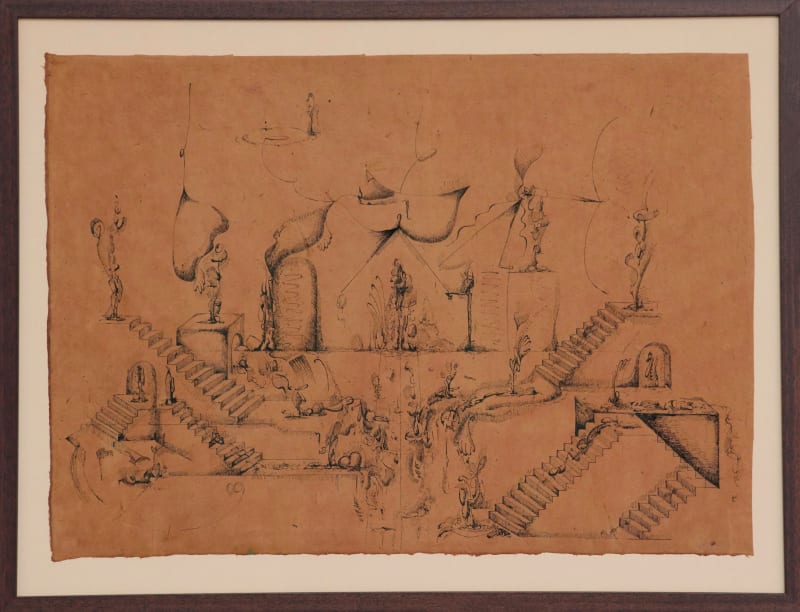Private View: Tuesday 8th February, 6:30-9pm
Berlin
Kristin Hjellegjerde Gallery Berlin’s latest exhibition Between Somewhere & Nowhere brings together a new video work by Peter Spanjer and a series of drawings, paintings and sculptures by Jack Bidewell in a timely exploration of liminality. Although the artist’s practices are materially and aesthetically diverse, they are connected by an interest in processes of abstraction as a way of expressing a psychological experience of a world in flux and how that might engender a feeling of freedom for both the artist and the viewer.
Peter Spanjer’s three-channel video work occupies the first gallery space, inviting audiences into an emotionally-charged immersive environment that explores identity and transformation in both a personal and collective sense. Although Spanjer typically embraces an intuitive approach to making art in which he builds up layers of sounds, imagery and text to create rich, multi-sensory experiences, he reflects on the making of this particular work as a process of reconnecting to his sense of self: ‘To me, this piece is about needing to find a place within yourself in order to gain some perspective, but it’s also about letting go and embracing that loss of control.’ During the research stages, in which he collects original and found footage, Spanjer found himself drawn to the notion and performance of surrender within a religious context. He notes, ‘The church is a place where, culturally, black people go to find a point of stillness and yet, the visualisation of spiritual surrender is often depicted in an intense and almost violent way: the holy spirit enters you and you fall onto the floor.’
In the video, Spanjer captures this balance between control and fluidity, calm and intensity by stitching together imagery and sound in a way that deliberately challenges the viewer’s perception of narrative progress or cohesion, while also reflecting on wider notions of harmony. At times, the footage plays out across all three screens creating a sense of wholeness while at others it jumps between the screens without any discernible pattern. The effect is initially unsettling as we are unable to grasp a stable sense of time or place, but as the piece unfolds, we are encouraged to let go and allow ourselves to experience the work without expectation or judgment. Meanwhile, the soundtrack alternates between Spanjer’s own composition and the original audio from found footage. In one particularly poignant sequence a woman singing in a choir cuts to a man talking about believing in yourself. While the latter scene is more direct in its messaging, it is the makeshift quality of the footage that appeals to our shared humanity by conveying a sense of intimacy and vulnerability. The interspersed imagery of flowers - a recurring motif in Spanjer’s work - serves a similar function by standing as a universal symbol of beauty and vitality that also probes at masculine ideals. In this new work, blooming flowers are paired with scenes of people being baptised, drawing a poetic connection between natural and personal growth, while also expressing a sense of hope and renewal that can be found in an encounter with nature, religion, or art.
Jack Bidewell's work also contemplates the transformational qualities of the artistic process. Inspired by An Attempt at Exhausting a Place in Paris, an experimental psycho-geographical book by Georges Perec, in which the author documents his observations of Saint-Sulpice Square in Paris, Bidewell began making drawings based on his everyday walk to work. The drawings are diaristic in manner, but rather than representing a fixed geographical site, they record a more abstract expression of place that relates not only to temporal conditions - the weather, a bird flying past, a glimpse of a green raincoat - , but also the artist’s emotional states. As such, each drawing possesses a distinct character. (Dis)Location, for example, depicts a series of arches and stairs pointing in different directions, conveying the artist’s interest, that day, in his architectural surroundings, while the forms in the work entitled They become unmappable appear more fluid and chaotic, evoking a powerful sense of turmoil - almost as if the space is collapsing in on itself.
Over time, Bidewell began to expand his visual observations into the medium of paint and sculpture. Based on the cracks in the paving stones of the bridge he crosses on his daily walk, the sculptural works play with tacility and negative space to create a tension between strength and fragility while the paintings employ colour to convey a more abstract sense of atmosphere. In the painting My spaces are fragile, for example, shapes float, untethered in space, appearing almost like debris churning in a sandstorm while stuttered marks of paint explode across the surface. ‘It is a form of map making,’ explains Bidewell, ‘but it’s more about space itself - the essence of space - rather than a specific location.’ Also on display are works from another experimental series in which Bidewell began by drawing a strict diagram that he then interpreted in order to observe his own instinctive responses and find alternative methods of abstraction. Interpretant is one of the resulting works in which we see the movement of the artist's hand, suspended in swirling gestures of thick oil paint.
In a sense, both Bidewell and Spanjer’s works enact a form of dislocation in which the viewer loses themselves in free-floating forms and fractured imagery, and whilst we might initially feel disorientated by the experience, it also invites us to embrace a more liberated perspective, unbounded by conventional notions of place or time.



